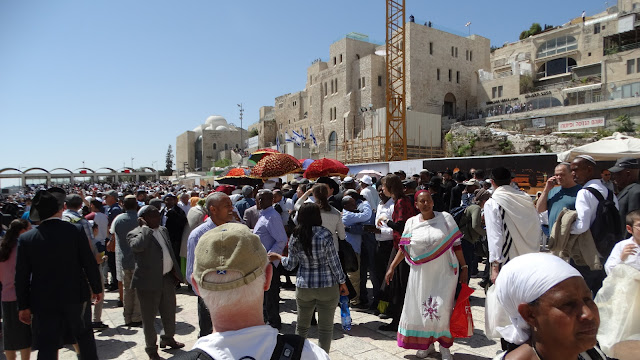The Western Wall, or “Wailing Wall”, is the most religious site in the world for the Jewish people. Located in the Old City ofJerusalem, it is the western support wall of the Temple Mount. Thousands of people journey to the wall every year to visit and recite prayers. These prayers are either spoken or written down and placed in the cracks of the wall. The wall is divided into two sections, one area for males and the other for females. It is one of the major highlights in any tour of the Old City.
Going to the Wailing Wall was an incredible experience for me. Even though I am not Jewish I was honored that I was permitted to join the throngs of people at the wall. Afterwards I reflected that for Jews the Wailing Wall gives them a strong sense of identity. It is a place where all Jews can gather, to pray, to read Scripture to be home. To be part of that for about an hour was very special.
Walking down to the wall.
Jews and (others) from all over the world.
Scene from near the wall.
Heading towards the male side of the wall.
Many were reading Scripture.
The devotion is very real.
A table full of Bibles in a variety of languages in front of the wall.
Why is it called the Wailing Wall?
This name is actually a translation of the Arabic term el-Mabka, which means “place of weeping,” and is the traditional Arab moniker for the wall. This description originated based on the Jewish practice of mourning the destruction of the Temple and praying for its rebuilding at the site of the Western Wall.
What is the significance of the Western Wall?
The Wall is adjacent to the location of many critical events in Jewish history. Here, Abraham demonstrated his devotion to God through his willingness to sacrifice his beloved son Isaac. This is the location where Isaac went to pray before meeting Rebecca, and where Jacob dreamed of the famous ladder reaching the Heavens. This is also the very place where the Holy Temple would eventually be built. In the present day, the Temple Mount still stands in this location, bereft without a Temple for all the nations of the world. From these events onward, Jerusalem has maintained its pivotal importance to the Jewish people. As scripture proclaims in Psalms 137:5-6, “If I forget thee O Jerusalem, may my right hand forget its skill. May my tongue cling to my palate if I do not remember you, if I do not bring up Jerusalem at the beginning of my joy.” Indeed, Jerusalem is mentioned 349 times by name in the Tanakh, the Jewish Bible, demonstrating its centrality to Judaism.
My Dear Great Ones,Going to the Wailing Wall was an incredible experience for me. Even though I am not Jewish I was honored that I was permitted to join the throngs of people at the wall. Afterwards I reflected that for Jews the Wailing Wall gives them a strong sense of identity. It is a place where all Jews can gather, to pray, to read Scripture to be home. To be part of that for about an hour was very special.
The covered bridge is for Muslims to get to their quarter of the Old City.
Jews and (others) from all over the world.
The umbrellas were held by Africans.
Scene from near the wall.
Heading towards the male side of the wall.
Many were reading Scripture.
The devotion is very real.
A table full of Bibles in a variety of languages in front of the wall.
Have a great week everyone.
Love adios and ping on!
Dirk















No comments:
Post a Comment
Note: Only a member of this blog may post a comment.